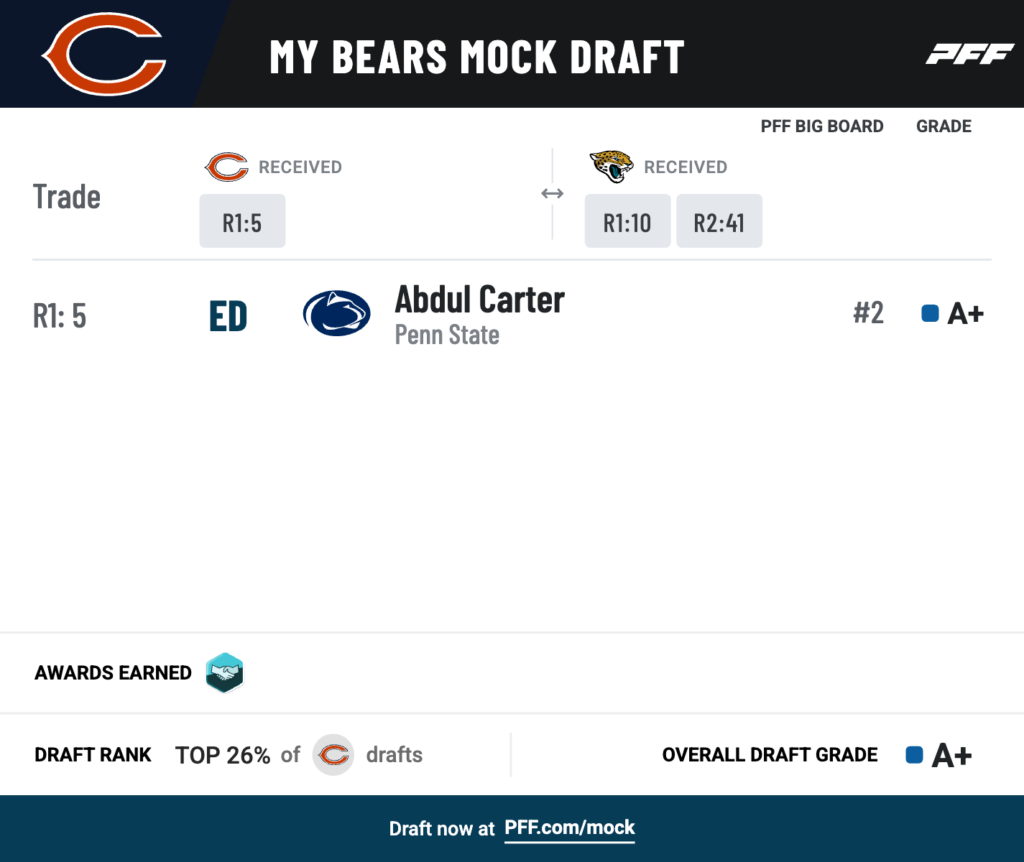- Chicago could make a play for the class’ top-ranked pass rusher: With how the first four picks may shake out, a deal to acquire Abdul Carter with the No. 5 pick could very well be in play for the Bears.
- The Chargers should be aggressive in targeting a receiver: While the cost of doing business may seem high, the value lies in maximizing quarterback Justin Herbert's prime.
- 2025 NFL Draft season is here: Try PFF's best-in-class Mock Draft Simulator and learn about 2025's top prospects while trading and drafting for your favorite NFL team.
Estimated Reading Time: 7 minutes
Last year's NFL draft did not disappoint in the trade department, with eight deals going down in Round 1 — three as a result of prior negotiations, including the Bears selecting No. 1 overall and another five coming on draft day itself. NFL teams love to wheel and deal once the clock starts ticking.
Here are four first-round trade ideas that could shake up the 2025 NFL Draft once the picks start flying.

Minnesota Vikings trade with Philadelphia Eagles, Tennessee Titans to move out of Round 1
Trade terms:
- Eagles receive Pick No. 24; Vikings receive Pick Nos. 32, 96 and 161
- Titans receive Pick No. 32; Vikings receive Pick Nos. 35 and 120
The first move on this list is almost necessary; Minnesota needs to trade back and gather more assets. The team holds just two selections within the first 100 picks (Nos. 24 and 97) and carries four picks in total. Although the Vikings were active in free agency, their developmental depth is a bit lacking, which will be the driving force behind this move.
Situated at the No. 24 pick, the Vikings could maneuver down twice — once into the backend of the first round with a team eyeing key defensive help and again with a team looking to take advantage of the fifth-year option awarded to first-round selections. That would be the antithesis of their active approach during the 2024 NFL Draft, in which they traded up twice.
With many teams at the end of the first round in need of pass-rush help, Minnesota could field calls from the Lions, Ravens, Commanders, Bills and Eagles, among others. Eagles general manager Howie Roseman could look to get aggressive to replenish his pass rush with a name like Donovan Ezeiruaku or James Pearce Jr., should they fall.
Then, Vikings general manager Kwesi Adofo-Mensah could again look to leverage the team’s new draft slot and move back once more. Armed with the No. 35 pick, the Titans could sneak back into Round 1 to acquire more talent for, presumably, their rookie signal-caller selected No. 1 overall — something PFF’s Dalton Wasserman projected in his most recent mock draft.
Turning the No. 24 pick into a package that includes Pick Nos. 35, 96,120 and 161 would be an excellent outcome for Minnesota.
Chicago Bears trade up to No. 5 with Jacksonville Jaguars for EDGE Abdul Carter
Trade terms:
- Bears receive Pick No. 5; Jaguars receive Pick Nos. 10 and 41
If this offseason has taught us anything, it’s that Bears general manager Ryan Poles isn’t shy about flexing his draft capital when he sees an opportunity. That very well could be the situation this team will find itself in should Abdul Carter fall out of the top four, the result of two quarterbacks being selected within that range or perhaps Will Campbell’s length concerns not scaring away a team like New England.

Although Chicago already worked to address its void on the edge by signing Dayo Odeyingbo to a three-year, $48 million contract in free agency, that shouldn’t disqualify them from getting aggressive here. The former Colts edge defender profiles as a good rotational pass rusher, but he has never surpassed a 70.0 PFF pass-rushing grade in a single season, which should leave something to be desired for the Bears.
With Jacksonville secure on the edge with Travon Walker and Josh Hines-Allen, new general manager James Gladstone could look to auction off the opportunity to draft Carter at the No. 5 pick, an offering many teams would be willing to make for a potential All-Pro-caliber player, even in a class flush with pass-rushing talent. Carter’s 99th-percentile marks in pass-rush win rate and PFF grade on true pass rushes over the past two seasons do well to support the case that he’s worthy of the extra capital it would require to move up for him.
Sliding back five picks would still leave the Jaguars with a top-10 player in this year’s draft — perhaps still in range for Mason Graham or Tyler Warren — as well as four selections within the top 75.
As for the Bears, the cost of one of their two second-round picks is a small price to pay for an impact starter at a premium position. Getting Carter at the No. 5 pick would cut the Carolina Panthers out of the picture — another team that would be all too happy to execute the move.
Los Angeles Chargers trade up to No. 16 with the Arizona Cardinals for WR Matthew Golden
Trade terms:
- Chargers receive Pick No. 16; Cardinals receive Picks No. 22, 86 and 181
The Chargers were noticeably quiet during this offseason’s free-agent cycle, particularly as it pertains to one of the roster’s most glaring needs: wide receiver. The most notable addition to the receiving corps came in the form of Mike Williams’ return to the team that drafted him, but not before the veteran receiver failed to catch on with a pair of squads in 2024, torpedoing his grading profile in the process.
Although something is better than nothing, the Chargers' need at receiver remains. Considering the talent drop-off at the position and many teams being in need and drafting ahead of Los Angeles, general manager Joe Hortiz can’t afford to let an opportunity to add to the group slip past him a second time. The Chargers would be wise to move up to beat the run on receivers, selecting a talent like Matthew Golden or perhaps Tetairoa McMillan — PFF’s third-ranked prospect — should either slide past the top 15.
Arizona would be a prime candidate to trade with in this scenario. Cardinals general manager Monti Ossenfort is known for wheeling and dealing on draft day, and after a solid haul of free-agent talent that addressed many of the team’s glaring needs, Arizona could be well positioned to drop a few picks in the order and gather more draft capital. Moving back to No. 22 would still allow the Cardinals to address their coverage holes, particularly at cornerback, while still being positioned in front of teams that will also target the position, such as the Packers, Vikings, Rams, Ravens and Bills.
While the cost of doing business may seem high, the value lies in maximizing quarterback Justin Herbert‘s prime following his career-best 91.2 PFF overall grade in 2024.



 © 2025 PFF - all rights reserved.
© 2025 PFF - all rights reserved.